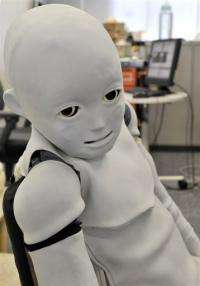Japan child robot mimicks infant learning

The creators of the Child-robot with Biomimetic Body, or CB2, say it's slowly developing social skills by interacting with humans and watching their facial expressions, mimicking a mother-baby relationship.
A bald, child-like creature dangles its legs from a chair as its shoulders rise and fall with rythmic breathing and its black eyes follow movements across the room.
It's not human -- but it is paying attention.
Below the soft silicon skin of one of Japan's most sophisticated robots, processors record and evaluate information. The 130-cm (four-foot, four-inch) humanoid is designed to learn just like a human infant.
"Babies and infants have very, very limited programmes. But they have room to learn more," said Osaka University professor Minoru Asada, as his team's 33 kilogram (73 pound) invention kept its eyes glued to him.
The team is trying to teach the pint-sized android to think like a baby who evaluates its mother's countless facial expressions and "clusters" them into basic categories, such as happiness and sadness.
Asada's project brings together robotics engineers, brain specialists, psychologists and other experts, and is supported by the state-funded Japan Science and Technology Agency.
With 197 film-like pressure sensors under its light grey rubbery skin, CB2 can also recognise human touch, such as stroking of its head.
The robot can record emotional expressions using eye-cameras, then memorise and match them with physical sensations, and cluster them on its circuit boards, said Asada.
The professor, also a member of the Japanese Society of Baby Science, said his team has made progress on other fronts since first presenting CB2 to the world in 2007.
In the two years since then, he said, CB2 has taught itself how to walk with the aid of a human and can now move its body through a room quite smoothly, using 51 "muscles" driven by air pressure.
In coming decades, Asada expects science will come up with a "robo species" that has learning abilities somewhere between those of a human and other primate species such as the chimpanzee.
And he hopes that this little CB2 may lead the way into this brave new world, with the goal to have the robo-kid speaking in basic sentences within about two years, matching the intelligence of a two-year-old child.
By 2050, Asada wants a robotic team of football players to be able take on the human World Cup champions -- and win.
Welcome to the cutting edge of robotics and artificial intelligence.
More than a decade since automaker Honda stunned the world with a walking humanoid P2, a forerunner to the popular ASIMO, robotics has come a long way.
Researchers across Japan have unveiled increasingly sophisticated robots with different functions -- including a talking office receptionist, a security guard and even a primary school teacher.
Electronics giant Toshiba is developing a new model of domestic helper, AppriAttenda, which moves on wheels and can fetch containers from a refrigerator with its two arms -- a potentially lucratic invention in fast-aging Japan.
"We aim to make a robot that elderly people can count on when living alone," said Takashi Yoshimi, a senior research scientist at a Toshiba laboratory in Kawasaki city south of Tokyo.
Last month also saw the debut of Japan's first robotic fashion model, cybernetic human HRP-4C, which can strut a catwalk, smile and pout thanks to 42 motion motors programmed to mimic flesh-and-blood models.
Its makers at the National Institute of Advanced Industrial Science and Technology outside Tokyo plan to sell the 158-centimetre fashion-bots for around 200,000 dollars each.
Thousands of humanoids could be working alongside humans in a decade or so, if that is what society wants, said Fumio Miyazaki, engineering science professor at the Toyonaka Campus of Osaka University.
If the world is ready for a functioning robot secretary, for example, there is "no need for a major technical breakthrough," he said.
A Tokyo subsidiary of Hello Kitty maker Sanrio, Kokoro -- which means heart or mind in Japanese -- has also produced advanced talking, life-size humanoids.
"Robots have hearts," said Kokoro planning department manager Yuko Yokota.
"They don't look human unless we put souls in them.
"When manufacturing a robot, there comes a moment when light flickers in its eyes. That's when we know our work is done."
Public opinion in Japan may be more open to robots than in the West, where dark science fiction visions from movies such as "Bladerunner" and "Terminator" have conjured images of robo-soldiers taking over the world.
Thanks to such benign cartoon characters as Astro Boy, "Japanese people have a friendly image towards robots," said Toshiba's Yoshimi.
Asada said Japan's indigenous animistic belief system may also have readied people to accept human-like robots with minds of their own.
"Everything has a mind -- the mind of the lamp, the mind of the chair, the soul of the desk," he said, pointing at objects in his office.
"Therefore the machines should have their mind too. If we proceed in this study, machines may have something like a human mind or 'robo-mind'," he said.
(c) 2009 AFP

















